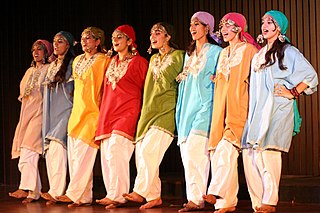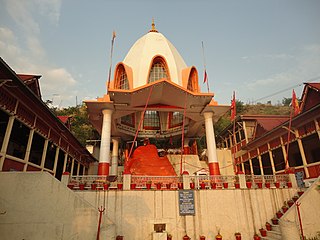
Kashmir is the northernmost geographical region of the Indian subcontinent. Until the mid-19th century, the term "Kashmir" denoted only the Kashmir Valley between the Great Himalayas and the Pir Panjal Range. Today, the term encompasses a larger area that includes the India-administered territories of Jammu and Kashmir and Ladakh, the Pakistan-administered territories of Azad Kashmir and Gilgit-Baltistan, and the Chinese-administered territories of Aksai Chin and the Trans-Karakoram Tract.

Srinagar is a city in Indian-administered Jammu and Kashmir in the disputed Kashmir region. It is the largest city and summer capital of Jammu and Kashmir, which is an Indian-administered union territory. It lies in the Kashmir Valley along the banks of the Jhelum River, and the shores of Dal Lake and Anchar Lakes, between the Hari Parbat and Shankaracharya hills. The city is known for its natural environment, various gardens, waterfronts and houseboats. It is also known for traditional Kashmiri handicrafts like the Kashmir shawl, papier-mâché, wood carving, carpet weaving, and jewel making, as well as for dried fruits. It is the second-largest metropolitan area in the Himalayas.

The history of Kashmir is intertwined with the history of the broader Indian subcontinent in South Asia with influences from the surrounding regions of Central, and East Asia. Historically, Kashmir referred to only the Kashmir Valley of the western Himalayas. Today, it denotes a larger area that includes the Indian-administered union territories of Jammu and Kashmir and Ladakh, the Pakistan-administered territories of Azad Kashmir and Gilgit-Baltistan, and the Chinese-administered regions of Aksai Chin and the Trans-Karakoram Tract.

The Kashmiri Pandits are a group of Kashmiri Hindus and a part of the larger Saraswat Brahmin community of India. They belong to the Pancha Gauda Brahmin group from the Kashmir Valley, located within the Indian union territory of Jammu and Kashmir. Kashmiri Pandits are Hindu Kashmiris native to the Kashmir Valley, and the only remaining Hindu Kashmiris after the large-scale of conversion of the Valley's population to Islam during the medieval times. Prompted by the growth of Islamic militancy in the valley, large numbers left in the exodus of the 1990s. Even so, small numbers remain.
Shingara, better known as Sultan Sikandar Shah Miri, also by his sobriquet Sikandar Butshikan was the seventh Sultan of Kashmir and a member of Shah Mir dynasty who ruled from 1389 until his death in 1413.

Kashmiris are an Indo-Aryan ethnolinguistic group speaking the Kashmiri language and originating from the Kashmir Valley, which is today located in Indian-administered Jammu and Kashmir.
Khrew is a town under municipal committee in Pulwama district in the Indian union territory of Jammu and Kashmir. It comes under Tehsil Pampore and District Pulwama of Union Territory of J&K. It is located at a distance of 20 km from Lal chowk city centre. It is famous for many things like a cement manufacturing hub where thousands of cement trucks are sent across the valley. It is also famous for the Indian army training camp where most of the new joinee soldiers get training and are sent to different places after the training is over. It is also famous for the education system having two higher secondary schools and many private schools. It is also famous for different religious places like Saint Sabir shah, Saint Syed shah Mantaqee, baba Qasim, and Jwala Mukhi Temple situated on the hilltop.

The Jamaat-e-Islami Kashmir or Jamaat-e-Islami Jammu and Kashmir (JIJK) is an Islamic political party based in the city of Srinagar in the Indian administered territory of Jammu and Kashmir. It is distinct from the Jamaat-e-Islami Hind. The organisation's stated position on the Kashmir conflict is that Kashmir is a disputed territory and the issue must be sorted as per UN or through tripartite talks between India, Pakistan and representatives of Kashmir.

Kashmiri Muslims are ethnic Kashmiris who practice Islam and are native to the Kashmir Valley, an area that includes the India-administered territories of Jammu and Kashmir and Ladakh, the Pakistan-administered territories of Azad Kashmir and Gilgit-Baltistan, and the Chinese-administered territories of Aksai Chin and the Trans-Karakoram Tract. The majority of Kashmiri Muslims are Sunni. They refer to themselves as "Koshur" in their mother language.

Ganga–Jamuni Tehzeeb, also spelled as Ganga-Jamni Tehzeeb or just Hindustani Tehzeeb, is the composite high culture of the central plains of northern India, especially the doab region of Ganges and Yamuna rivers, that is a syncretic fusion of Hindu cultural elements with Muslim cultural elements. The composite Ganga-Jamuni culture emerged due to the interaction between Hindus and Muslims in the history of South Asia.
Islam is the majority religion practised in Kashmir, with 97.16% of the region's population identifying as Muslims as of 2014. The religion came to the region with the arrival of Mir sayed Ali shah Hamdani, a Muslim Sufi preacher from Central Asia and Persia, beginning in the early 14th century. The majority of Kashmiri Muslims are Sunni Muslims, and Shias account for between 20% and 25% of the Muslim population, who mostly reside in north and central Kashmir. They refer to themselves as "Koshur" in their mother language. Non-Kashmiri Muslims in Kashmir include semi-nomadic cowherds and shepherds, belonging to the 𝙂𝙪𝙟𝙟𝙖𝙧𝙨 and Bakarwal communities.

The Rishi order is a religious tradition, concept for the mystical teaching or spiritual practices associated with religious harmony of Sufism in the Kashmir Valley. The sufi saint of Rishi order influenced Kashmiris and its culture. The prominent Rishis of the valley include Resh Mir Sàeb and Nund Rishi, also known as Sheikh Noor-ud-din Wali. The Rishi order has made an important contribution to Kashmiriyat, the ethnic, national, social and cultural consciousness of the Kashmiri people, as well as a distinctive contribution to global Islam.

Kashmiri Hindus are ethnic Kashmiris who practice Hinduism and are native to the Kashmir Valley of India. With respect to their contributions to Indian philosophy, Kashmiri Hindus developed the tradition of Kashmiri Shaivism. After their exodus from the Kashmir Valley in the wake of the Kashmir insurgency in the 1990s, most Kashmiri Hindus are now settled in the Jammu division of Jammu and Kashmir and other parts of the country. The largest group of Kashmiri Hindus are the Kashmiri Pandits.

Religious harmony in India is a concept that indicates that there is love, affection between different religions throughout the history of the Indian subcontinent. In the modern-day Republic of India, the Indian constitution supports and encourages religious harmony. In India, every citizen has a right to choose and practice any religion. There are examples of Muslims and Sikhs building temples together. In India, different religious traditions live harmoniously. Seers of religions call for religious harmony in India. For popular film stars in India like Salman Khan, festivals of Hindus and Muslims are equal. According to Dalai Lama, India is a model for religious harmony. He mentions that "In the last 2000-3000 years, different religious traditions, such as Jainism, Islam, Sikhism, and others, have flourished here.". The whole concept of religious harmony is the most valuable treasure of India. In a lecture organized on the silver jubilee of Seshadripuram Educational Trust, Dalai Lama further said that though religions have various philosophies and spiritual traditions, all of them carry the same message of love. He also emphasized the importance of acknowledging each other as brothers and sisters. As mentioned by Dalai Lama, reviving ancient Indian knowledge helps us to live peacefully and in perfect harmony with other communities. This kind of knowledge guides us to the right path and paves the way for a happy and peaceful community and world.

The Exodus of Kashmiri Hindus, or Pandits, is their early-1990 migration, or flight, from the Muslim-majority Kashmir valley in Indian-administered Kashmir following rising violence in an insurgency. Of a total Pandit population of 120,000–140,000 some 90,000–100,000 left the valley or felt compelled to leave by the middle of 1990, by which time about 30–80 of them are said to have been killed by militants.

Nund Rishi, also known as Sheikh Noor-ud-Din Noorani, Sheikh-Ul-Alam and by the title Alamdar-e-Kashmir, was a Kashmiri Sufi saint, mystic, poet and Islamic preacher. Nund Rishi was among the founders of the Rishi order, a Sufi tradition of the region. He influenced many spiritual teachers and saints, including Hamza Makhdoom, Resh Mir Sàeb, and Shamas Faqir.

The following outline is provided as an overview of and topical guide to Jammu and Kashmir:
The Kashmiris in Punjab are ethnic Kashmiris who have historically migrated from the Kashmir Valley and settled in the Punjab region. Many ethnic Muslim Kashmiris from the Kashmir Valley had migrated to the Punjab region during Sikh and Dogra rule.
Under Dogra rule, people in the princely state of Jammu and Kashmir launched several political movements. Despite ideological differences and varying goals they aimed to improve the status of Muslims in a state ruled by a Hindu dynasty.

Jwala Ji Temple or Jwalamukhi Temple is Hindu shrine in the town of Khrew in the Pulwama district of Jammu and Kashmir, India.















